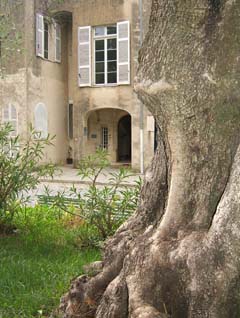
|
The Renoir museum is in the Villa des Collettes where
Renoir spent his last dozen years with his wife and sons. The
visitor enters a small parking
lot and then walks past an ancient olive grove on the way through the
grounds to the villa. The farm "Les Colletes" was depicted by
Renoir in many paintings and is part of the museum.
|

|
The house itself is
somewhat modest but had several extra rooms for visitors. I was
surprised to find that Renoir had it built because it looks like it has
been there much longer. The
rooms used by Renoir for his painting have been kept as they
were. His atelier was the one of the largest rooms in the house
and had an expanse of glass facing north. It was centered around
a
wheel chair and a
wooden easel in front of various props for classical poses. To
the right of the easel and chair is a utilitarian wooden rack on which
was stored several paintings (each probably worth millions now.)
On the entry level, there are a
number of paintings and sculptures by Renoir during his stay in the
villa. I was pleased to be able to get close enough to see the
texture of the paint because this was entirely new for me. I have
seen much of his work in books or at a distance but to be able to see
how the paint was laid down (somewhat haphazardly) helped me to
appreciate his contribution because they are not obvious from
photographs that I have seen. Renoir did his first sculptures
here with a young sculptor named Richard Guino who stayed with Renoir
for a number of years. The
sculpture is realistic in form but surfaced with quick moves similar
to the gestures in Renoir's paintings. Most are portraits or
classic themes like a mother breastfeeding an infant in a classically
aesthetic
pose. The bronze seems to have been
based on terracotta originals and has a very dark petina. I was
not allowed to take
pictures.
A nice touch was the presence of many photographs of
Renoir. In some of them he is hunched over in front of a canvas
painting as one would expect an old man to paint: grasping the brush
with an arthritic hand and guiding it with failing eyes, waiting until
it arrived at the desired position before applying paint (the work did
not suffer).
The rooms not specifically used by Renoir are now empty except
for artwork by some of the many artists that came to pay homage to the
master. The art of Renoir's visitors falls in basically two
themes: the grounds as they were
in the time while Renoir stayed in the villa and Renoir himself at
various
ages (mostly of him at the time of his stay here in Cagne sur
Mer).
|

|
I had read that no one
could visit without feeling touched. Matisse wrote
after his visit (in 1917) that "Never have I seen so happy a man and I
have promised that, in my turn, I will not be cowardly." For me
the
experience of visiting the house of this master could be summarized by
an image of the chair in his
bedroom. It was a simple wooden chair that had been worn smooth
from use. The rails that formed the seat were extended in back to
form handles and also in front (but hinged to fall out of the way) so
that two strong adults could carry its
occupant. No doubt the young sculptor Guino was
at one end of that chair most times. Perhaps the stout young
visitor was at the other. Renoir lived in the villa
for 12 years. The handles on the chair show it.
This ancient olive tree outside Renoir's back door looks exactly
the same in the many of
the drawings and paintings from a century ago. In the background
is the "Haut-de-Cagnes" the medieval city of Cagnes atop a hill and
centered around a watch tower which was later converted into a castle
by some prince. The tree is about six feet in diameter at the
base which makes it old enough to have been planted when the old city
was being built.
|

|
The gift/bookshop is located in the small farmhouse
next
door to the villa. I didn't get to go in because it was lunchtime
and everything was closing (including the grounds) for two hours.
The hours are from 10-noon then 2-6 (5 starting October). The
French love their famous artists but nobody is going to miss a meal
over them.
|



